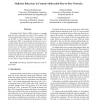274 search results - page 35 / 55 » Identifying sets of key players in a social network |
BMCBI
2010
13 years 7 months ago
2010
Background: It has been long well known that genes do not act alone; rather groups of genes act in consort during a biological process. Consequently, the expression levels of gene...
SIGECOM
2004
ACM
14 years 25 days ago
2004
ACM
Lack of cooperation (free riding) is one of the key problems that confronts today’s P2P systems. What makes this problem particularly difficult is the unique set of challenges ...
FLAIRS
2010
13 years 9 months ago
2010
When data instances are inter-related, as are nodes in a social network or hyperlink graph, algorithms for collective classification (CC) can significantly improve accuracy. Recen...
COLCOM
2008
IEEE
13 years 9 months ago
2008
IEEE
Networked virtual environments (NVE) refer to the category of distributed applications that allow a large number of distributed users to interact with one or more central servers i...
CNSR
2005
IEEE
13 years 9 months ago
2005
IEEE
Distributed Hash Tables (DHTs) promise to manage huge sets of key-value pairs in a Peer-to-Peer manner. The Content-Addressable Network (CAN) is a prominent variant of DHT. A crit...

